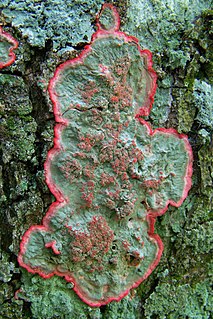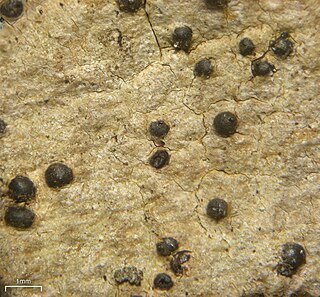
The Arthoniales is the second largest order of mainly crustose lichens, but fruticose lichens are present as well. The order contains around 1500 species, while the largest order with lichenized fungi, the Lecanorales, contains more than 14000 species.

Ramalina is a genus of greenish fruticose lichens that grow in the form of flattened, strap-like branches. Members of the genus are commonly called strap lichens or cartilage lichens. Apothecia are lecanorine.

Lithothelium is a genus of lichen-forming fungi in the family Pyrenulaceae. Most of the species are found in tropical climates, and are usually corticolous (bark-dwelling) or saxicolous (rock-dwelling). The genus was circumscribed by Swiss botanist Johannes Müller Argoviensis in 1885.

Cryptothecia is a genus of white to greenish crustose lichens that grow on bark, wood, or leaves. in tropical or subtropical areas worldwide. It has a conspicuous prothallus that develops around its periphery which can be bright red in some species, hence the common name wreath lichen. The main vegetative body (thallus) lacks a cortex (ecorticate and is often immersed in the substrate or byssoid. The medulla is white, well defined, and often peppered with calcium oxalate crystals. Ascomata are not well defined, being cushions of soft white mycelium immersed in the medullary tissue, hence the name from the Greek krypto = "to conceal" and theke = "a container or sheath". There are about 45 described species in the genus according to one source, and 75 species according to another. The genus is in the family Arthoniaceae. It contains Trentepohlia, a green alga, as its photobiont partner.
Dolichocarpus is a genus of lichens in the family Opegraphaceae. The genus was circumscribed by lichenologist Rolf Santesson in 1949, with Dolichocarpus chilensis assigned as the type species. This species, found in Chile, grows on cactus spines in a fog desert. For several decades the genus remained monotypic, until 2008 when André Aptroot added Dolichocarpus seawardii. This lichen, found on St Helena, forms large patches on wet, overhanging rock ledges.
André Aptroot is a Dutch mycologist and lichenologist.
A corticolous lichen is a lichen that grows on bark. This is contrasted with lignicolous lichen, which grows on wood that has had the bark stripped from it, and saxicolous lichen, which grows on rock.

Punctelia perreticulata is a widely distributed species of foliose lichen in the family Parmeliaceae. It occurs in Mediterranean Europe and Russia, North America, South America, Australia, and New Zealand, where it grows on rocks, bark, or wood. Its main distinguishing features are its thallus surface, marked with many shallow depressions, grooves, or pits, and sorediate pseudocyphellae. The lower side of the thallus is ivory to tan towards the centre and the major secondary metabolite in the medulla is lecanoric acid. A lookalike species with which it has been historically confused is Punctelia subrudecta; this lichen can be distinguished from Punctelia perreticulata by the texture of the thallus surface, or, more reliably, by the length of its conidia.

Herpothallon is a genus of crustose lichens in the family Arthoniaceae. It has about 50 species.
Cladonia inflata is a rare species of terricolous (ground-dwelling) lichen in the family Cladoniaceae. Found in Bahia, Brazil, it was formally described as a new species in 2018 by lichenologists André Aptroot and Marcela Eugenia da Silva Cáceres. The type specimen was collected by the authors from Palmeiras, on the Mount of Pai Inácio, at an altitude between 1,050 and 1,140 m ; here the lichen was found growing on siliceous sandstone rock in a transitional forest. Cladonia inflata is only known to occur at the type locality, and is only known from the type specimen. At this location the lichen is conspicuous but not abundant, and forms extensive mats with many other Cladonia species, such as C. bahiana, C. clathrata, C. dissecta, C. divaricata, C. friabilis, C. furfuracea, C. metaminiata, C. miniata, C. obscurata, C. parvipes, C. pityrophylla, C. polyscypha, C. salmonea, C. secundana, and C. substellata. The lichen has a fruticose (bushy), mineral-grey thallus that consists of upright hollow podetia measuring about 4 to 7 cm high, atop a cushion up to 10 cm (4 in) in diameter. It contains the secondary compound fumarprotocetraric acid. The specific epithet inflata refers to the inflated thallus of the lichen.
Neoprotoparmelia capitata is a species of corticolous (bark-dwelling) and crustose lichen in the family Parmeliaceae. It is found in eastern North America.
Synarthonia leproidica is a species of saxicolous (rock-dwelling) and crustose lichen in the order Arthoniales. Found in Luxembourg, it was formally described as a new species in 2020 by lichenologists Damien Ertz, André Aptroot, and Paul Diederich. The type specimen was collected in the Vallée du Lellgerbaach (Lellingen) at an elevation of 323 m (1,060 ft). Here the lichen was found on a siliceous wall at the edge of a forest path in an oak-hornbeam forest. It has a pale greyish crust-like thallus with dark brown/violet tinges. It has a leproid growth form, meaning that it looks like it is made of granules; the specific epithet refers to this characteristic. The thallus forms patches that are about 0.5–5 mm in diameter, although neighbouring patches can coalesce to form larger patches up to 10 cm (4 in) in diameter. Synarthonia leproidica contains psoromic acid, a secondary chemical that can be detected with thin-layer chromatography.
Henricus (Harrie) Johannes Maria Sipman is a Dutch lichenologist. He specialises in tropical and subtropical lichens, and has authored or co-authored more than 250 scientific publications. He was the curator of the lichen herbarium at the Berlin Botanical Garden and Botanical Museum from 1983 until his retirement in 2010.
Astrothelium aeneoides is a species of corticolous (bark-dwelling), crustose lichen in the family Trypetheliaceae. It is found in Brazil, Guyana, and Puerto Rico, where it grows on the smooth bark of rainforest trees.
Mark Richard David Seaward is a British ecologist and lichenologist. He was awarded the Acharius Medal in 2006 for lifetime contributions to lichenology.
Astrothelium lucidomedullatum is a species of corticolous (bark-dwelling), crustose lichen in the family Trypetheliaceae. Found in Ecuador, it was formally described as a new species in 2016 by Dutch lichenologist André Aptroot. The type specimen was collected by Harrie Sipman from the Reserva Biológica San Francisco at an altitude of 2,025 m (6,644 ft); there, it was found in a rainforest growing on smooth bark. The lichen has a quite smooth and shiny, pale ochraceous-green thallus with a cortex but lacking a prothallus, covering areas of up to 5 cm (2 in) in diameter. The medulla contains lichexanthone, a lichen product that causes its tissue to fluoresce when lit with a long-wavelength UV light. The main characteristics of the lichen distinguishing it from others in Astrothelium are its ascospores, which number four per ascus and have dimensions of 80–115 by 25–35 μm; the presence of lichexanthone in the medulla; and the structure of the immersed ascomata, which have separate ostioles and are covered by the thallus.
Astrothelium perspersum is a species of corticolous (bark-dwelling), crustose lichen in the family Trypetheliaceae. Found in Gabon, it was formally described as a new species in 2016 by lichenologists André Aptroot and Damien Ertz. It is one of the few Trypetheliaceae species known only from Africa. The type specimen was collected by the second author between the villages of Massaha and Batouala ; there, it was found in a rainforest growing on smooth tree bark. The lichen has a smooth and somewhat shiny, pale greenish-grey thallus with a cortex and a thin black prothallus line. It covers areas of up to 4 cm (1.6 in) in diameter. The presence of the lichen does not induce the formation of galls in the host plant. No lichen products were detected from collected specimens using thin-layer chromatography. The combination of characteristics of the lichen that distinguish it from others in Astrothelium are the dimensions of its ascospores ; and the arrangement and form of its ascomata—from irregular groups to pseudostromatic, with the pseudostromata erumpent, and white. Astrothelium perspersum is somewhat similar to A. scoria, but has larger ascospores than that species.
Astrothelium pseudannulare is a species of corticolous (bark-dwelling), crustose lichen in the family Trypetheliaceae. Found in Ecuador, it was formally described as a new species in 2016 by Dutch lichenologists André Aptroot and Javier Etayo. The type specimen was collected from the Podocarpus National Park at an altitude of 3,000 m (9,800 ft); there, it was found in a montane forest growing on smooth tree bark. The lichen has a smooth and shiny, olive-green thallus comprising patches of cortex that break through the host bark, covering areas about 1.0 to 3.5 mm in diameter. No lichen products were detected from collected samples of the lichen using thin-layer chromatography. The combination of characteristics of the lichen that distinguish it from others in Astrothelium are the rough thallus; the distribution of the ascomata, which ranges from solitary to irregularly confluent; and the form of the ascomata, which ranges from prominent to sessile. The ascospores are hyaline, spindle-shaped (fusiform), and have three septa; they measure 62–80 by 20–25 μm. The species epithet pseudannulare alludes to its resemblance to Astrothelium annulare, another species with large 3-septate spores.
Astrothelium pseudodissimulum is a species of corticolous (bark-dwelling), crustose lichen in the family Trypetheliaceae. Found in Papua New Guinea, it was formally described as a new species in 2016 by Dutch lichenologist André Aptroot. The type specimen was collected by Harrie Sipman in Brahman Mission at an altitude of 100 m (330 ft); there, it was found in a rainforest growing on smooth tree bark. The lichen has a smooth, pale yellowish-green thallus with a cortex but lacking a prothallus. It covers areas of up to 15 cm (6 in) in diameter. The only lichen product detected in collected samples of the lichen using thin-layer chromatography was an anthraquinone. The combination of characteristics of the lichen that distinguish it from others in Astrothelium are its inspersed hamathecium; pigment in the medulla that reacts K+ (red); and the pseudostromatic form of the ascomata, with whitish-coloured, erumpent to prominent pseudostromata.
Astrothelium rimosum is a species of corticolous (bark-dwelling), crustose lichen in the family Trypetheliaceae. Found in Guyana and Colombia, it was formally described as a new species in 2016 by Dutch lichenologist André Aptroot. The type specimen was collected by Harrie Sipman in Kaieteur National Park at an altitude of 400 m (1,300 ft); there, in a sclerophyllous forest, it was found growing on smooth tree bark. The lichen has an olive-green to yellowish-green thallus with a thick, hyaline cortex, and a yellow medulla. The thallus texture is chinked and fissured (rimose); its species epithet rimosum alludes to this characteristic. the lichen covers areas of up to 9 cm (3.5 in) in diameter. Its thallus and medulla contain an anthraquinone that results in a K+ (red) chemical spot test. The combination of characteristics of the lichen that distinguish it from others in Astrothelium are the external and internal yellow pigment of its ascomata, and the form and dimensions of its ascospores.





